| کد مقاله | کد نشریه | سال انتشار | مقاله انگلیسی | نسخه تمام متن |
|---|---|---|---|---|
| 4270139 | 1610870 | 2014 | 8 صفحه PDF | دانلود رایگان |

IntroductionA new classification of premature ejaculation (PE) has been proposed, including the categories of lifelong PE (LPE), acquired PE (APE), natural variable PE (NVPE), and premature‐like ejaculatory dysfunction (PLED).AimThe aim of this study was to evaluate the impact of intravaginal ejaculation latency time (IELT) and erectile function on anxiety and depression among patients with PE in general and according to the four types of PE.MethodsBetween September 2011 and September 2012, we conducted a cross‐sectional study in the Anhui province of China. We enrolled 4,000 men aged over 18 years, each of whom had been in a stable, monogamous, heterosexual relationship with the same partner for at least 6 months.Main Outcome MeasurementsSelf‐estimated IELT, the International Index of Erectile Function‐5 (IIEF‐5) and the Zung Self‐Rating Anxiety and Depression Scales (SAS/SDS) were used to measure PE, erectile dysfunction (ED), anxiety, and depression, respectively, among the entire study population.ResultsOf the 3,016 men evaluated, 25.80% complained of PE. Distribution of the four types of PE among men with PE was as follows: LPE, 12.34%; APE, 18.77%; NVPE, 44.09%; PLED, 24.81%. Men with PE presented lower IIEF‐5 scores and higher SAS and SDS scores vs. men without PE (P < 0.001 for all). Similar findings were observed in men with APE when compared with other PE syndromes. After adjustment for age in men with PE, IELT was negatively associated with SAS and SDS scores (SAS, adjusted r = −0.42, P < 0.001; SDS, adjusted r = −0.45, P < 0.001). IIEF‐5 score was negatively associated with SAS and SDS scores (SAS, adjusted r = −0.54, P < 0.001; SDS, adjusted r = −0.50, P < 0.001). These negative relationships were strongest in men with PLED (IELT vs. SAS: adjusted r = −0.63, P < 0.001; IELT vs. SDS, adjusted r = −0.60, P < 0.001; IIEF‐5 vs. SAS: adjusted r = −0.57, P < 0.001; IELT vs. SDS, adjusted r = −0.55, P < 0.001).ConclusionsAPE patients reported higher rates of ED, anxiety, and depression than men with other types of PE. The negative relationships between IELT/IIEF‐5 and SAS/SDS were strongest in men with PLED. Gao J, Zhang X, Su P, Peng Z, Liu J, Xia L, Lu Z, Yang J, Tang D, Gao P, Zhou J, Hao Z, and Liang C. The impact of intravaginal ejaculatory latency time and erectile function on anxiety and depression in the four types of premature ejaculation: A large cross‐sectional study in a Chinese population. J Sex Med 2014;11:521–528.
Journal: The Journal of Sexual Medicine - Volume 11, Issue 2, February 2014, Pages 521–528